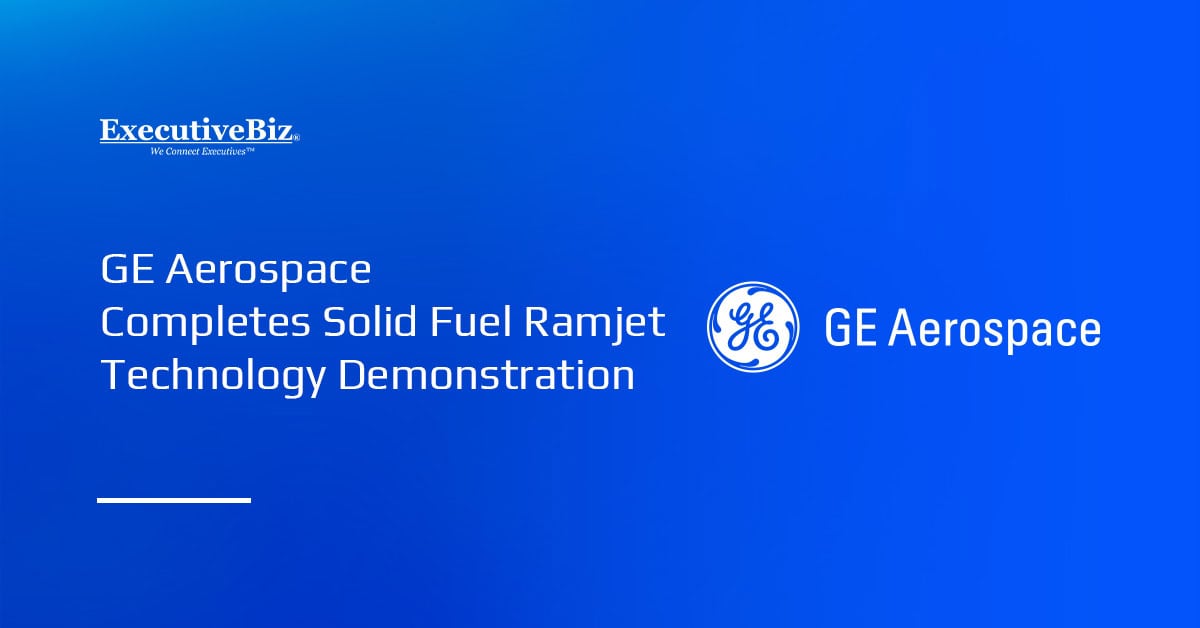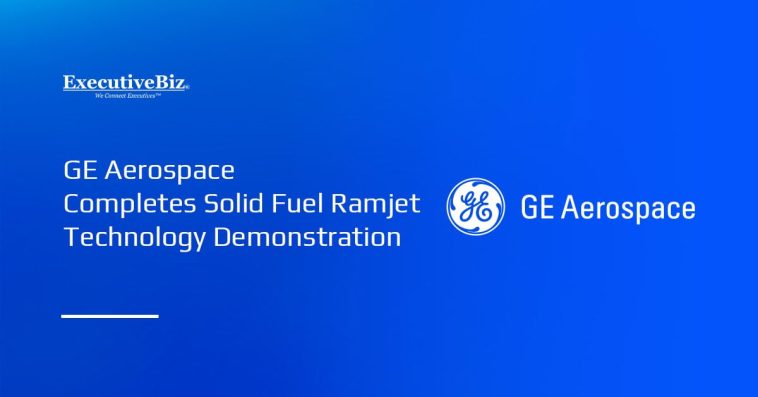
GE Aerospace and the Future of Supersonic Propulsion
GE Aerospace’s recent achievement in completing supersonic captive carry flight tests of its Atmospheric Test of Launched Airbreathing System (ATLAS) Flight Test Vehicle marks a turning point in the evolution of propulsion technology. With the successful demonstration of their solid fuel ramjet (SFRJ) propulsion system, the company has underlined its commitment to pushing the envelope of high-speed aerodynamics and innovative defense strategies. The new test campaign, carried out on a Lockheed F-104 Starfighter, not only highlights the prowess of GE Aerospace’s engineering teams but also emphasizes the importance of cutting-edge research in the broader field of aerospace and defense.
In this opinion editorial, we will take a closer look at the compelling journey of GE Aerospace as it navigates through the challenging yet exciting realm of supersonic flight testing. Along the way, we will examine the technological breakthroughs, the government-backed funding that has spurred this initiative, and the broader implications for military and commercial applications. We will also explore what this achievement means for the future of high-speed propulsion systems and how it could influence competing industries in automotive and industrial manufacturing.
Advancements in Solid Fuel Ramjet Propulsion Technology
The breakthrough in solid fuel ramjet propulsion technology is more than just a technical accomplishment—it is a strategic milestone that could redefine the way we think about air-breathing propulsion systems. By integrating a solid fuel ramjet into their ATLAS flight test vehicle, GE Aerospace has successfully demonstrated that traditional propulsion methods can be outpaced by innovative systems capable of meeting the extremes of supersonic flight. This system is designed to extend the range of munitions and provide enhanced speed, range, and responsiveness, outcomes that are critical for modern aerial defense.
At the heart of this technology lies a clever blend of proven aerodynamics and inventive engineering solutions designed to tackle the tricky parts and tangled issues associated with high-speed flight. Unlike conventional engines that require separate air intake and exhaust systems, a solid fuel ramjet simplifies the design by using onboard fuel combined with atmospheric oxygen. This process not only reduces weight and complexity but also opens up new possibilities for designing lightweight, mission-critical components in both military and commercial applications.
The ATLAS project serves as a live demonstration of high-speed flight where key performance characteristics are validated through in-flight testing. For the first time, GE Aerospace has effectively shown that frequent captive carry tests conducted under realistic atmospheric conditions can comfortably capture the subtle details of system behavior. While the advancement might seem intimidating to some, it is actually a clear indicator that the future of supersonic propulsion is both bright and far-reaching.
Testing in Real-World Conditions: Captive Carry Flight Trials
One of the most fascinating aspects of the recent campaign is the use of a captive carry system. By leveraging the storied Lockheed F-104 Starfighter as the carrier aircraft, GE Aerospace has proven that high-altitude, high-speed tests can be safely and effectively conducted in real-world conditions. This method of hosting a test vehicle on an existing, proven carrier not only mitigates risk but also allows engineers to gather data in a flight environment that simulates operational challenges.
The captive carry approach enables more frequent testing since there is no need to orchestrate a full-scale launch for each trial. Such a setup is particularly valuable when trying to understand the little details of system behavior amid the unpredictable twists and turns of high-speed atmospheric flight. During the campaign, the ATLAS test system was successfully carried aloft on three flights, and in each instance, it reached supersonic speeds. These results are a testament to GE Aerospace’s ability to figure a path through the intricacies of high-speed flight testing.
There are several significant benefits to using a captive carry method: it allows for controlled conditions, provides ample opportunity to monitor and adjust system parameters, and – crucially – reduces the nerve-racking elements associated with free-flight tests. Furthermore, engineers are better equipped to poke around for potential issues and fine-tune the propulsion system in subsequent tests, ensuring that every component is optimized for both performance and reliability.
Government Support and Strategic Funding
The ATLAS project enjoys significant backing from the Department of War under Title III of the Defense Production Act. This support is not only a boon for GE Aerospace but also a clear signal that government agencies recognize the tactical importance of advanced air-breathing propulsion systems. The funding strategy is designed to scale up the technology, ensuring that the benefits of improved speed, range, and responsiveness can be realized on a broad scale.
Government funding in this realm serves as an essential component that bridges the sometimes daunting gap between innovative design and practical application. The financial backing allows companies like GE Aerospace to invest in areas that might otherwise be considered too nerve-racking to pursue. In this instance, the involvement of the Department of War has fostered an environment in which cutting-edge research can meet real-world needs, producing experimental results that have vast implications for future defense capabilities.
By injecting significant resources into the ATLAS program, stakeholders are effectively taking the wheel of innovation. This strategic collaboration between industry and government is designed to overcome the confusing bits and challenging pieces of aerospace R&D, paving the way for future advancements that could revolutionize both military defense systems and commercial flight technologies.
Overcoming Technical Challenges: Handling Tricky Parts and Complicated Pieces
The development and testing of supersonic propulsion systems are not without their tricky parts and tangled issues. High-speed flight introduces a host of complications—from managing extreme aerodynamic forces to ensuring the durable performance of propulsion components in harsh atmospheric conditions. GE Aerospace’s approach involves extensive captive carry testing, which allows engineers to work through these challenges in a controlled yet realistic setting.
One area that posed significant hurdles was the integration of the solid fuel ramjet system into an existing flight platform. The delicate balance of weight distribution, fuel management, and aerodynamic stability requires that each component be meticulously calibrated. By conducting multiple tests, the engineering teams have been able to identify subtle parts that need fine-tuning, reducing the possibility of unforeseen complications during full-scale deployment.
Here are some of the key technical challenges addressed during the tests:
- Maintaining structural integrity at supersonic speeds
- Ensuring smooth combustion processes within the compact engine design
- Managing heat dissipation under extreme conditions
- Optimizing fuel consumption for sustained high-speed performance
- Integrating with legacy flight systems while introducing new propulsion methods
These challenges, while intimidating at first glance, have been met with a robust, data-driven approach. The comprehensive testing not only helps in sorting out the confusing bits but also provides a foundation for future iterations of the propulsion system. Each flight offers a unique opportunity to get into the nitty-gritty of the system’s behavior, ultimately ensuring that the technology can be trusted in high-stakes scenarios.
Lessons Learned from the ATLAS Flight Campaign
The results of the ATLAS flight tests provide a wealth of data that will undoubtedly shape the trajectory of further aerospace research. By examining the outcomes of these tests, it becomes clear that this phase is not just about proving the concept—it is about laying the groundwork for future technologies that could transform both military and commercial aviation.
One of the major takeaways from the flight campaign is the value of iterative testing. Each of the three successful flights provided engineers with essential insights into the performance of the SFRJ technology under different atmospheric conditions. Such repetitive testing is critical to understanding and addressing the subtle twists and turns of real-world flight.
There are several lessons that stakeholders in aerospace and related industries can derive from this campaign:
- Incremental Testing: Continuous validation through repeated trials helps identify hidden complexities and fine points.
- Data-Driven Design: Detailed data collection and analysis enable enhancements that directly respond to observed deficiencies.
- Collaborative Innovation: Effective partnerships between government and industry foster an environment ripe for breakthrough innovations.
- Adaptability: The ability to quickly tweak system components based on test feedback is critical for handling the challenging twists inherent in high-speed flight.
This iterative approach not only underlines the necessity of routine testing but also emphasizes the importance of thorough data analysis. By bulking up on quality data, GE Aerospace is better equipped to manage your way through the maze of high-speed flight challenges, ensuring that future systems are both reliable and capable of pushing the limits of current technological standards.
Modernizing Test Facilities: Upgrades and Infrastructure Enhancements
GE Aerospace’s recent advances are backed by a broader commitment to modernizing its testing infrastructure. Over the past few years, the company has made significant investments in state-of-the-art facilities at its Evendale, Ohio; Bohemia, New York; and Niskayuna, New York sites. These upgrades are designed to support higher-Mach testing and mission-relevant trials at a scale that was simply not possible before.
The expanded capabilities of these facilities have several implications for the future of aerospace testing:
- Enhanced Testing Capabilities: Higher-Mach, mission-relevant testing allows for more realistic simulation of flight conditions, aiming to capture even the subtlest differences in performance.
- Increased Testing Frequency: With upgraded infrastructure, engineers can conduct more frequent tests, which helps in rapidly iterating on design improvements and troubleshooting complicated pieces.
- Broader Application Spectrum: Modern facilities can support not only supersonic tests but also broader hypersonic propulsion challenges, opening avenues for various high-speed applications.
These investments represent a forward-looking strategy that could have ripple effects across various aerospace and manufacturing sectors. Upgraded facilities are not only critical for executing the current flight test campaigns but are also a must-have for supporting the next wave of innovations in both military and civilian aerospace applications. The commitment to modernizing these infrastructures underscores GE Aerospace’s readiness to take the wheel when it comes to pioneering future propulsion systems.
Geopolitical Implications and the Future of Defense Technology
The integration of solid fuel ramjet technology into operational systems has profound implications beyond the realm of aerospace engineering. As nations around the globe seek to enhance their defense capabilities, technologies such as those demonstrated in the ATLAS project play a pivotal role in informing strategic decisions in military spending and procurement.
Government agencies worldwide are now more focused than ever on investing in next-generation propulsion systems that promise superior performance and enhanced mission capabilities. In this light, the ATLAS project is poised to influence future defense doctrines in several important ways:
- Enhanced Defensive Posture: Superior propulsion systems can extend the range and speed of missiles and unmanned systems, significantly altering the balance of power on the global stage.
- Dual-Use Potential: The underlying technology behind solid fuel ramjets is not limited to military applications—it also has promising applications in commercial aviation and even emerging sectors like electric vehicles, where advanced thermal management of propulsion systems is a key concern.
- Encouraging Collaborative Ventures: The successful demonstration of such advanced technology may lead to stronger ties between governments and private industry, creating more opportunities for collaborative R&D in high-speed propulsion and related fields.
While the complexities of geopolitics are full of twists and turns, one thing is clear: advancements in propulsion technology can and will have a cascade of effects across varying sectors. As GE Aerospace continues its work and other companies take note of these breakthroughs, we can expect new collaboration patterns to emerge, along with a more dynamic approach to research funding and innovation in defense technology.
Industry Crossovers: Impact on Automotive and Industrial Manufacturing
The evolution of solid fuel ramjet propulsion technology, while primarily aimed at enhancing defense systems, has ripple effects that extend into other industries, notably automotive and industrial manufacturing. As these sectors grapple with their own technological hurdles, many of the innovations emerging from advanced aerospace propulsion research could soon find practical applications in more terrestrial contexts.
For instance, the refined techniques in thermal management, material science, and fuel efficiency developed during the ATLAS flight tests offer insights that can be adapted for use in electric vehicles and high-performance industrial machinery. In automotive engineering, where reducing weight while increasing efficiency is a constant challenge, lessons from aerospace propulsion systems can serve as a valuable reference point.
Key areas of potential crossover include:
- Lightweight Composite Materials: The materials engineered for high-speed flight tests are designed to withstand intense heat and dynamic loads. These materials could be used to create more durable, lightweight components for electric vehicles and automotive parts.
- Advanced Fuel Systems: The integrated fuel management systems in solid fuel ramjet technology demonstrate efficient fuel delivery in extreme conditions, inspiring improvements in automotive engine design.
- Precision Testing Techniques: The rigorous testing protocols used in aerospace can help industrial manufacturing develop more sophisticated methods for quality assurance and performance calibration, particularly in high-stress operating environments.
These intersections underscore how advancements in one field can unexpectedly boost progress in another. The knowledge gained in supersonic flight testing not only helps engineers figure a path through the complicated pieces of aerospace challenges but also provides practical guidance for industries that are constantly searching for ways to innovate in a competitive landscape.
Marketing and Business Implications in a Changing Economic Landscape
The strides made by GE Aerospace in the field of supersonic propulsion also have notable implications for the broader business world—particularly in terms of marketing and economic strategy. As companies invest in increasingly innovative technologies, the narrative around advanced propulsion systems plays a crucial role in shaping public perception and investor confidence.
Marketing campaigns that focus on technological breakthroughs often highlight the essential progress made in research and development, positioning companies like GE Aerospace as pioneers in an evolving industry. These stories not only attract further investment but also encourage additional government support as well as private partnerships. In a landscape that is sometimes filled with confusing bits and complicated pieces, a well-crafted narrative can help bridge the gap between technical language and public understanding, making the innovation story accessible to a broader audience.
Business leaders and decision-makers can draw several insights from GE Aerospace’s approach:
- Highlighting Innovation: Emphasizing technological breakthroughs in marketing materials can elevate a brand’s position as an industry leader.
- Bridging Industry Gaps: The cross-industry applications of supersonic propulsion technology illustrate the value of investing in research that transcends traditional boundaries.
- Investor Confidence: Demonstrable progress in cutting-edge technology, validated by rigorous testing and government support, boosts investor confidence and opens up further avenues for funding.
- Collaborative Momentum: Partnerships between government agencies and private industry not only pave the way for advanced research but also enhance the reputation of companies willing to take calculated risks in emerging fields.
The business implications of such technological achievements are super important. For companies in industries as diverse as automotive manufacturing and small business tech development, the ripple effects of breakthroughs in aerospace are a reminder that the future is interconnected. With each successful test flight and technological milestone, the narrative around progress becomes richer and more compelling, suggesting that the future of innovation is both interconnected and fundamentally transformative.
Looking Ahead: The Road to Commercialization and Broader Adoption
While the recent tests mark a significant achievement, the journey is far from over. It is crucial to recognize that the evolution of solid fuel ramjet technology and its pathway to commercialization is an ongoing process laden with both opportunities and challenging bits.
GE Aerospace has set a robust foundation, and now the focus shifts to scaling the technology for broader adoption. Future steps may include:
- Further Flight Testing: Conducting additional tests to refine performance data, while addressing any unexpected small distinctions observed during previous flights.
- Integration with Next-Generation Platforms: Tailoring the propulsion technology to work seamlessly with both existing military defense systems and potential commercial aerospace applications.
- Collaborative Research Initiatives: Working with other industry players to share knowledge and develop complementary technologies that enhance overall system effectiveness.
- Market Strategy and Public Outreach: Creating detailed narratives that explain the benefits of high-speed propulsion technology to a broad audience, including policymakers, investors, and the general public.
Each of these steps represents a strategic move toward making the technology accessible and practical. The ability to carefully test, iterate, and publicize the benefits of the ATLAS project will be essential not just for GE Aerospace’s market success, but also for spurring industry-wide interest in next-generation propulsion systems.
The transition from prototype to full-scale implementation can be nerve-racking. However, the iterative approach taken so far provides valuable assurance that the technology is on track to surmount the hidden challenges. As the advancements continue to gain momentum, we anticipate that this could mark the start of a new era in high-speed propulsion—a development that will likely have a far-reaching impact on international defense strategies and even influence the future of private aerospace ventures.
Impact on Small Business and the Broader Tech Ecosystem
Interestingly, the ripple effects of the ATLAS project extend beyond the realms of large aerospace manufacturers and defense contractors. In today’s dynamic ecosystem, even small businesses can benefit from the technological spill-over generated by such large-scale projects. Start-ups and niche technology firms are already exploring ways to incorporate advanced materials, innovative fuel systems, and precise testing methodologies into their offerings.
Small businesses in the manufacturing sector—especially those involved in the production of lightweight composites or precision engineering components—stand to gain from the breakthroughs made in aerospace testing. These companies can serve as suppliers or collaborators, driving innovation in areas that were once considered too complex or intimidating due to the high technical barriers of entry.
Key considerations for small businesses include:
- Adopting Advanced Materials: Leveraging innovations in composite materials to improve product performance in industrial applications.
- Integrated Quality Testing: Utilizing rigorous testing protocols modeled after aerospace standards to ensure reliability and performance in their own products.
- Cross-Industry Collaboration: Establishing partnerships with larger companies or tech start-ups to develop complementary products that can benefit from high-speed propulsion technology research.
- Marketing Innovation: Using success stories from large-scale projects like the ATLAS campaign to build credibility and showcase the small business’s ability to work on the cutting edge of technology.
This cross-pollination of ideas and technology is super important for creating a robust and sustainable ecosystem. As small businesses figure a path through the usually overwhelming maze of advanced technologies, they also begin to play an increasingly important role in the innovation chain, making the entire ecosystem more dynamic and resilient.
Final Thoughts: A New Chapter in High-Speed Propulsion
GE Aerospace’s accomplishment in completing supersonic captive carry tests of its ATLAS Flight Test Vehicle is more than a singular event—it is indicative of a broader trend towards innovation in high-speed propulsion and advanced aerospace technologies. Through iterative testing, modern infrastructure enhancements, and strategic government funding, GE Aerospace is demonstrating that even the most intimidating challenges in aerospace R&D can be managed thoughtfully and thoroughly.
This journey, filled with tricky parts, confusing bits, and challenging twists, offers a clear message to the industry: continued investment in research and development leads to breakthroughs that impact not just defense systems, but also spill over into commercial aviation, automotive engineering, and even small business innovation. By embracing the delicate art of iterative testing and comprehensive design analysis, GE Aerospace is setting the stage for a future where high-speed, air-breathing propulsion systems are not only viable—they are essential.
Looking forward, the path to commercialization will require ongoing commitment, collaboration, and adaptability. The lessons learned from the ATLAS test campaign provide a roadmap for all players in the aerospace and defense sectors, underlining the necessity of frequent testing, the importance of government-industry partnerships, and the myriad benefits of crossing traditional industry boundaries.
In a world where technological progress is as fast-paced as the supersonic speeds achieved by the ATLAS project, we must continuously steer through the complicated pieces of innovation with both caution and ambition. As challenges arise, so too do opportunities. It is incumbent upon decision-makers in government, industry, and small business alike to harness the insights gleaned from these tests and apply them in ways that spur economic growth, strengthen national defense, and push the boundaries of what is possible.
As the lines between military, commercial, and industrial applications of advanced propulsion technology continue to blur, we find ourselves at a pivotal moment—one where success in one arena can trigger breakthroughs across multiple sectors. The modern ecosystem of innovation thrives on collaboration, adaptability, and the courage to take calculated risks in areas that might initially seem overwhelming.
The ATLAS project, with its solid fuel ramjet advancements and innovative testing strategies, offers an inspiring blueprint for future exploration and development. Whether you are an engineer, a business leader, or simply an enthusiast of groundbreaking technology, this event beckons us all to take a closer look at the limitless possibilities of modern aerospace engineering.
In conclusion, GE Aerospace’s supersonic test campaign is not just a story of technological triumph—it is a signal flare heralding a new chapter in supersonic propulsion. As we watch these developments unfold over the coming years, one thing is certain: the innovations tested today will form the backbone of the advanced, interconnected, and dynamic aerospace systems of tomorrow. With each successful flight and every meticulously analyzed data point, we are indeed witnessing the future of high-speed propulsion in real time—a future that promises to transform not only the way we fly, but the very nature of global technological progress.
Originally Post From https://www.aero-mag.com/ge-aerospace-completes-supersonic-tests-of-atlas-vehicle
Read more about this topic at
Supersonic transport
Research in Supersonic Flight and the Breaking of …


